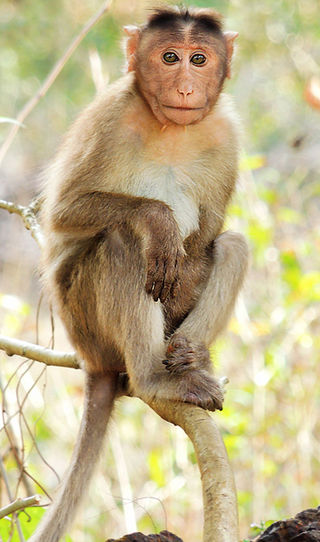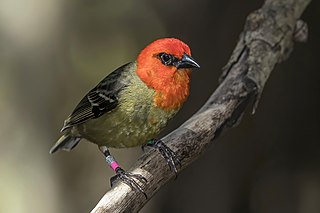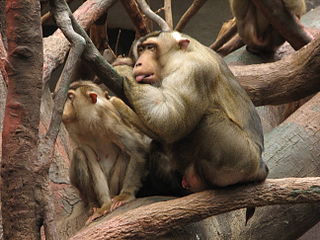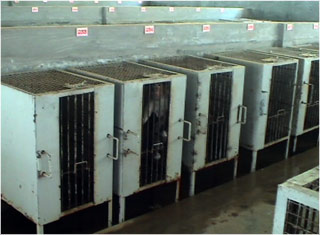
The macaques constitute a genus (Macaca) of gregarious Old World monkeys of the subfamily Cercopithecinae. The 23 species of macaques inhabit ranges throughout Asia, North Africa, and Gibraltar. Macaques are principally frugivorous, although their diet also includes seeds, leaves, flowers, and tree bark. Some species, such as the crab-eating macaque, subsist on a diet of invertebrates and occasionally small vertebrates. On average, southern pig-tailed macaques in Malaysia eat about 70 large rats each per year. All macaque social groups are matriarchal, arranged around dominant females.

The crab-eating macaque, also known as the long-tailed macaque and referred to as the cynomolgus monkey in laboratories, is a cercopithecine primate native to Southeast Asia. A species of macaque, the crab-eating macaque has a long history alongside humans. The species has been alternately seen as an agricultural pest, a sacred animal, and, more recently, the subject of medical experiments.

Brodmann area 23 (BA23) is a region in the brain that lies inside the posterior cingulate cortex. It lies between Brodmann area 30 and Brodmann area 31 and is located on the medial wall of the cingulate gyrus between the callosal sulcus and the cingulate sulcus.

The Celebes crested macaque, also known as the crested black macaque, Sulawesi crested macaque, or the black ape, is an Old World monkey that lives in the Tangkoko reserve in the northeastern tip of the Indonesian island of Sulawesi (Celebes), as well as on smaller neighboring islands.

Ubud is a town on the Indonesian island of Bali in Ubud District, located amongst rice paddies and steep ravines in the central foothills of the Gianyar regency. Promoted as an arts and culture centre, it has developed a large tourism industry. It forms a northern part of the Greater Denpasar metropolitan area.

The Mauritius fody is a rare species of bird in the weaver family. It is endemic to the island of Mauritius. It is classified by BirdLife International as being endangered. It is also on the United States' Endangered Species List with an endangered status.

Golden Hill Country Park or Kam Shan Country Park, also known in Hong Kong as Monkey Hill, established on 24 June 1977, is a country park located in the ranges north of Kowloon, Hong Kong. It covers an area of 3.37 square kilometres (1.30 sq mi). Most of the area is covered by the Kowloon Group of Reservoirs. Inside the park, there are jogging trails, barbecue and picnic areas, which are easily accessible from Tai Po Road via waterworks access roads. The park takes its name from the 369 metres (1,211 ft) peak, Golden Hill or Kam Shan (金山), which is the highest feature in the area.

The Nicobar long-tailed macaque is a subspecies of the crab-eating macaque, endemic to the Nicobar Islands in the Bay of Bengal. This primate is found on three of the Nicobar Islands—Great Nicobar, Little Nicobar and Katchal—in biome regions consisting of tropical and subtropical moist broadleaf forests.

Uluwatu Temple is a Balinese Hindu sea temple located in Uluwatu. The temple is regarded as one of the sad kahyangan and is dedicated to Sang Hyang Widhi Wasa in his manifestation as Rudra.

The southern pig-tailed macaque, also known as the Sundaland pig-tailed macaque and Sunda pig-tailed macaque, is a medium-sized macaque that lives in southern Thailand, Malaysia, and Indonesia. It is known locally as berok.

Nafovanny in Vietnam is the largest captive-breeding primate facility in the world, supplying long-tailed macaques to animal testing laboratories, including Huntingdon Life Sciences in the UK and Covance in Germany.

Great Natuna Island or just Natuna is the main island of the Middle Natuna Archipelago, which is part of the Riau Islands Province, Indonesia. It is also called Great Bunguran Island.

Moyo is an island in Indonesia's West Nusa Tenggara province. It is off the north coast of Sumbawa Island, and has an area of 349 km2. Moyo Island is located in Sumbawa Regency within the Nusa Tenggara province, just north of Sumbawa. The island has an area of 32,044 hectares, about 8° south of the equator. The island is proposed as part of Moyo Satonda National Park along with Satonda Island.

Mandala Suci Wenara Wana, also known as Ubud Monkey Forest, is a sanctuary located at Padangtegal Ubud, Bali, Indonesia

The Philippine long-tailed macaque is a subspecies of the crab-eating macaque, known in various Philippine languages as matching/matsing or the more general term unggoy ("monkey"). It is endemic to the Philippine forests and woodlands, but especially in the mangrove forests of western central Philippines— particularly in Palawan, the Visayas, and Mindanao. The names M. f. philippinensis and M. f. philippinenesis have also been used, but arise from orthographical error.
Plasmodium inui is a species of parasite, one of the species of simian Plasmodium that cause malaria in Old World monkeys.
M. fascicularis may refer to:
Entopolypoides is a genus of parasites belonging to the phylum Apicomplexa.
On 29 September 1986, thanks to a decree by the Minister of Environment, the ‘Moyo Island Hunting Park’ was established. It is a Natural Reserve covering 22,537.90 hectares, currently managed by the Conservation Bureau of West Nusa Tenggara. This area is home to long tail macaques, wild bovines, wild pigs, deer and 21 bat species, including flying foxes. Bird watching enthusiasts can observe 86 species of birds, 2 of them endangered: the yellow headed parrot and the Tanimbar megapode which is endemic to Indonesia. It nests in large sandy heaps, litter and other debris, where the heat generated by the decomposition of the organic material serves to incubate the eggs. Inside the Park there are also a few waterfalls, the biggest one is about 2 hours from Labuan Aji village, the others are in easy reach, within 15 minutes walking distance, in the forest where there are colorful butterflies. Most of the east and west coasts and the entire south coast of Moyo Island have been declared Marine Park. Pristine coral reefs and all their inhabitants are now protected from fishing and pollution.















